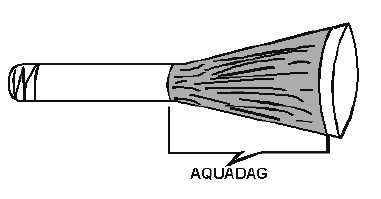2-21
THE CRT SCREEN
The inside of the large end of a CRT is coated with a fluorescent material that gives off light when
struck by electrons. This coating is necessary because the electron beam itself is invisible. The material
used to convert the electrons’ energy into visible light is a PHOSPHOR. Many different types of
phosphor materials are used to provide different colored displays and displays that have different lengths
of PERSISTENCE (duration of display).
In one way, the CRT screen is similar to a tetrode vacuum tube. Both suffer from the effects of
secondary emission. In order to reach the screen, electrons from the cathode are accelerated to relatively
high velocities. When these electrons strike the screen, they dislodge other electrons from the material of
the screen. If these secondary emission electrons are allowed to accumulate, they will form a
negatively-charged barrier between the screen and the electron beam, causing a distorted image on the
CRT screen. The method used to control secondary emission, which you are already familiar with, i.e., a
suppressor grid, is not practical in CRT’s. Instead, a special coating called an AQUADAG COATING is
applied to the inside of the tube as shown in figure 2-21. This coating is composed of a conductive
material, such as graphite, and has the same high-positive potential applied to it that is applied to the
accelerating anode. This allows the aquadag to perform two functions. First, since the aquadag coating is
positive, it attracts the secondary emitted electrons and removes them. Second, because the aquadag is
operated at a high-positive potential and is mounted in front of the accelerating anode, it aids in the
acceleration of electrons toward the screen.
Figure 2-21.—Aquadag coating in a CRT.
Before going on, let’s review what you have already learned about CRT operation.
1. Electrons are emitted from a specially constructed cathode and move toward the front of the
CRT.
2. The number of electrons that leave the area of the cathode is determined by the cap-shaped grid.
In addition, the grid concentrates the emitted electrons into a beam.
3. The electron beam is focused and accelerated toward the screen by two electrodes: the focusing
anode and the acceleration anode.
4. The electron beam strikes the screen and causes a bright spot to appear at the point of impact.
5. Any electrons released by secondary emission are removed from the tube by the aquadag
coating.

